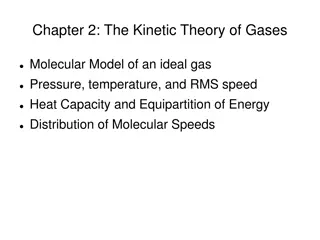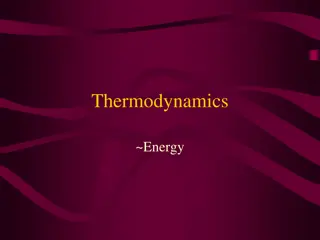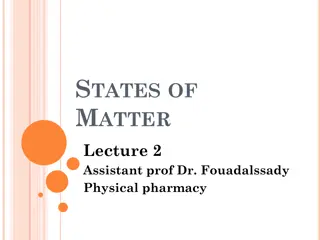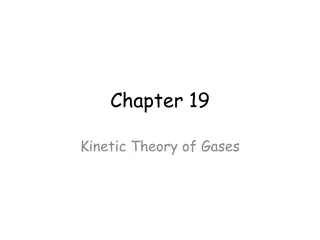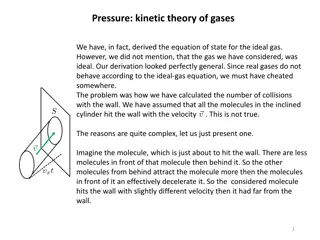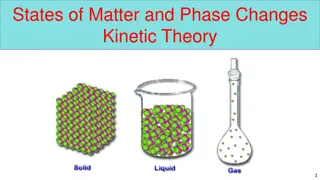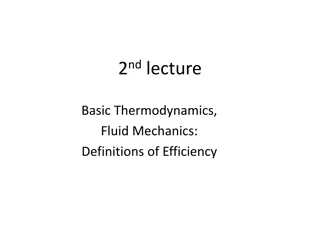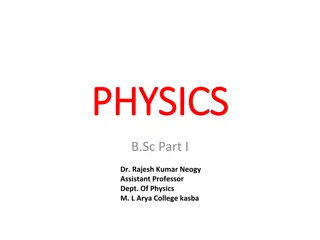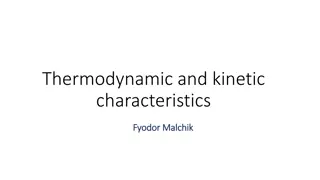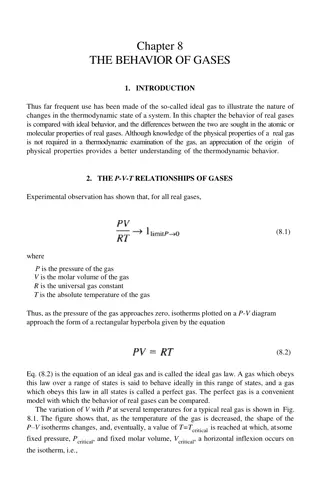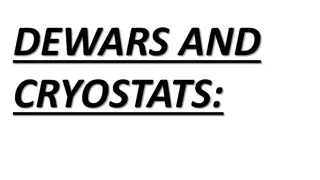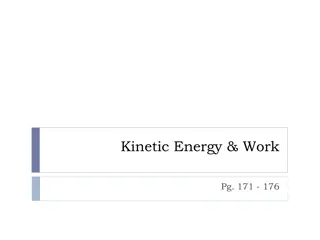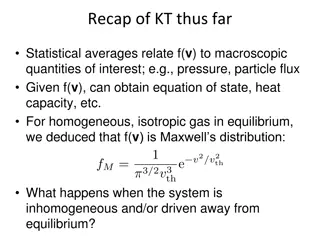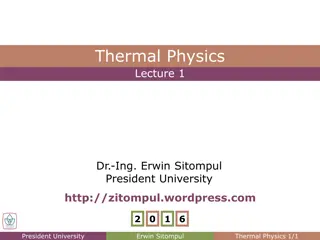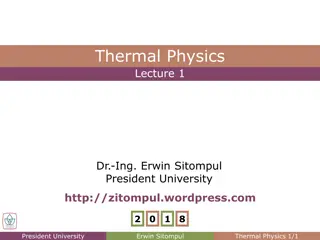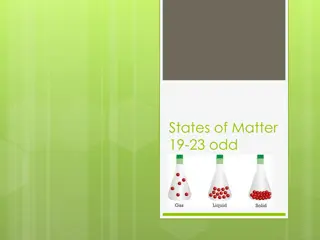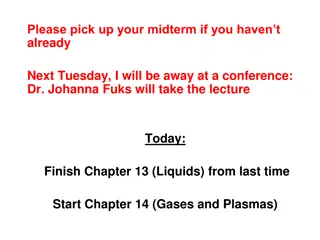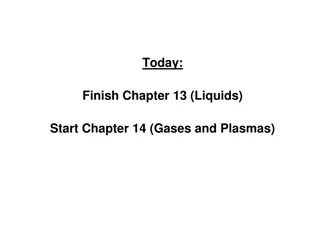Understanding Kinetic Theory of Gases and Thermodynamics
Explore the fundamental principles of the kinetic theory of gases, including the five postulates and the relationship between macroscopic properties and microscopic phenomena. Delve into the concept of entropy and thermodynamics, along with the behavior of ideal and real gases. Gain insights into the laws of thermodynamics, entropy, and phase equilibria, and learn about Gibbs and Helmholtz's free energies.
Download Presentation

Please find below an Image/Link to download the presentation.
The content on the website is provided AS IS for your information and personal use only. It may not be sold, licensed, or shared on other websites without obtaining consent from the author. Download presentation by click this link. If you encounter any issues during the download, it is possible that the publisher has removed the file from their server.
E N D
Presentation Transcript
Small Test State the five postulates of kinetic theory of gases Define Thermodynamics What is Entropy? 2
Presentation Outline 1) Kinetic Theory of Gases, Ideal gas 2) Behavior of Real Gas 3) Thermodynamics : Laws of Thermodynamics 4) Entropy 5) Gibb s and Helmholtz s Free Energies 6) Phase Equilibria 3
Kinetic Theory of Gases Kinetic Theory of Gases: A Brief Review The kinetic theory of gases correlates between: Macroscopic properties and Microscopic phenomena Kinetics means the study of motion, and in this case motions of gas molecules. 4
Kinetic Theory of Gases Daniel Bernoulli & Air Pressure; 1738 Molecular point of view Molecules of air ; Corpuscles, when they strike against the piston and sustain it by their repeated impacts, form an elastic fluid which will expand of itself if the weight is removed or diminished. 5
Kinetic Theory of Gases Kinetic Theory of Gases: A Brief Review Newton had shown that PV = constant if the repulsion were inverse-square. Avogadro had conjectured that equal volumes of different gases at the same temperature and pressure contained equal numbers of molecules We can from all these easily relate the gas pressure to the molecular velocities . 6
Kinetic Theory of Gases Postulates A gas consists of a collection of small particles traveling in straight-line motion and obeying Newton's Laws. The molecules in a gas occupy no volume (that is, they are points). Collisions between molecules are perfectly elastic (that is, no energy is gained or lost during the collision). There are no attractive or repulsive forces between the molecules. The average kinetic energy of a molecule is 3kT/2. (T is the absolute temperature and k is the Boltzmann constant.) 7
Kinetic Theory of Gases IDEAL AND REAL GAS LAWS Gases, unlike solids and liquids have indefinite shape and indefinite volume. As a result, they are subject to pressure changes, volume changes and temperature changes. Real gas behavior is actually complex. For now, let's look at ideal Gases, since their behavior is simpler. By understanding ideal gas behavior, real gas behavior becomes more tangible. How do we describe an ideal gas? An ideal gas has the following properties: 8
Kinetic Theory of Gases IDEAL AND REAL GAS LAWS:Properties An ideal gas is considered to be a "point mass". A point mass is a particle so small, its mass is nearly zero. This means an ideal gas particle has virtually no volume. Collisions between ideal Gases are "elastic". This means that no attractive or repulsive forces are involved during collisions. Also, the kinetic energy of the gas molecules remains constant since theses interparticle forces are lacking. Volume and temperature are by now familiar concepts. Pressure, however, may need some explanation. Pressure is defined as a force per area. When gas molecules collide with the sides of a container, they are exerting a force over that area of the container. This gives rise to the pressure inside the container. 9
Kinetic Theory of Gases IDEAL AND REAL GAS LAWS At the same temperature and volume, the same numbers of moles of all gases exert the same pressure on the walls of their containers. This is known as Avogadros principle 10
Kinetic Theory of Gases IDEAL AND REAL GAS LAWS For a gas, the pressure, volume, temperature and moles of the gas are all related by the following equation: 11
Kinetic Theory of Gases IDEAL AND REAL GAS LAWS R = 0.0821 L. atm/mol. K. This unit requires Volume to be expressed in liters, Pressure in atmospheres, Temperature in Kelvin. Problems Dealing With The Ideal Gas Law Suppose you have 1.00 mol of a gas at 0oC, occupying a container which is 500 mL in size. What is the pressure of this gas in atmospheres? 12
Kinetic Theory of Gases IDEAL AND REAL GAS LAWS Using the ideal gas law PV = nRT First Step, convert all known values to the correct units Convert: Celsius to Kelvin, given T = 0oC K = oC + 273 = 0oC + 273 = 273 K Volume to liters, given V = 500 mL 13
Kinetic Theory of Gases IDEAL AND REAL GAS LAWS Now insert the known values into the ideal gas law, PV = nRT n = 1.00 mol T = 0oC P = ? V = 500mL R= 0.0821 L. atm/mol. K Make P the subject 14
Kinetic Theory of Gases IDEAL AND REAL GAS LAWS Now let's find how many moles of gas are present when the gas is occupying a volume of 5.00 L at a pressure of 10.0 atmospheres and a temperature of 310 K. Substitute the pressure, volume, temperature and the gas constant, R, into the ideal gas law equation: 15
Kinetic Theory of Gases IDEAL AND REAL GAS LAWS Inserting the known values into the ideal gas law, PV = nRT We have; Solving for n we have; 16
Kinetic Theory of Gases The gas laws developed by Boyle, Charles, and Gay- Lussac are based upon empirical observations and describe the behavior of a gas in macroscopic terms, that is, in terms of properties that a person can directly observe and experience. An alternative approach to understanding the behavior of a gas is to begin with the atomic theory, which states that all substances are composed of a large number of very small particles (molecules or atoms). In principle, the observable properties of gas (pressure, volume, temperature) are the consequence of the actions of the molecules making up the gas. 17
Kinetic Theory of Gases Boyle's Law The relationship between pressure and volume while holding moles and temperature constant is called Boyle's Law Let us derive Boyle s Law from the ideal gas law, let there be two conditions, pressures 1 and 2 Volumes 1 and 2 both at the same Temperature. Then for the same number of moles P1V1 =nRT P2V2 = nRT 18
Kinetic Theory of Gases Boyle s Laws Since both pressures and volumes are equal to nRT, they are equal to each other: P1V1 = P2V2 = nRT (Boyle's Law) Example Suppose you had gas in a 15.0 L container at 5.00 atmospheres pressure and the volume is decreased to 0.500 L. What is the new pressure in the container? To recognize that this is a Boyle's Law problem, make yourself a table of the known quantities and the unknown quantity. 19
Kinetic Theory of Gases Boyle s Laws Substitute the known variables into the equation for Boyle's Law (5.00 atm)(15.0 L) = P2(0.500 L) Make sure that the volume units are consistent Make P2 the subject 20
Kinetic Theory of Gases Boyle s Laws Note that from our calculation, pressure and volume are inversely proportional, so as volume decreases, the pressure increases. 21
Charles' Law Charles s Law state that a sample of gas at constant pressure will have a volume which is directly proportional to its temperature. V T Volume V increases with increasing temperature T if pressure is kept constant. In another word the ratio of volume to temperature for a fixed mass of gas remains constant, provided external pressure is not altered. i.e V T = Constant ( Linear relationship b/w V & T) 22
Charles' Law If we take V T Let us introduced a constant K Then Dividing both side by T we get V/T = K This is valid at standard states that means Temperature must be in Kelvin. If we have two gas conditions V1/T1 = K and V2/T2 = K We can say V1/T1 = V2/T2 23
Charles' Law Examples 1 A gas inside a balloons has a volume of 1dm3 at 298K. If the gas is warmed to 350K what will be the new volume? Assume the pressure remains constant. 2Suppose you had 25.0 L of gas at 0 oC, and you raised the temperature to 100 oC. What is the new volume of the gas? 24
Charles' Law For Q2. The first task is to immediately change the temperature values from Celsius to Kelvin. T1 = 0 oC + 273 = 273 K T2 = 100 oC + 273 = 373 K Given are V1 = 25.0L T1 = 273K V2 =? T2 = 373K 25
Charles' Law Substitute the known temperatures and volume into the expression for Charles' Law i.e V1/T1 = V2\T2 Solve for V2 by multiplying both sides of the equation by T2, 373 K 26
Charles' Law 27
The Combined Gas Law What happens if none of the variables for a gas are constant (pressure, volume, temperature, and moles of the gas were changed)? The result would be the Combined Gas Law. Let's derive this law. Give pressure, volume, moles and temperature subscripts, since they are all changing. P1 V1 = n1RT1 P2V2 = n2RT2 Divide each equation by their respective mole and temperature term 28
The Combined Gas Law Example. suppose you had a gas at 15.0 atm pressure, at a volume of 25.0 L and a temperature of 300 K. What would the volume of the gas be at standard temperature and pressure? Standard pressure is 1.00 atm and standard temperature is 0 oC (or 273 K) 29
The Combined Gas Law Given are : Substitute these variables into the combined gas law, mole is the same therefore we have 30
The Combined Gas Law Solve the volume, V2. Multiply both sides of the equation by 273 K and divide both sides of the equation by 1.00 atm: 31
Work examples: Ideal Gas 1) standard temperature and pressure, STP, is 0oC (273 K) and 1atm. Calculate the standard molar volume of an ideal gas at STP Solution: The standard molar volume is the volume occupied by one mole at 273-K and 1 atm . From the ideal gas equation PV = nRT, we can solve for V Given P=1atm, T = 273 K or 0oC , and n = 1 therefore V = (1)(0.082)(273)/(1) V = 22.4L 32
Work Example Continue 2) If 10 L of O3 (g) react completely to form O2(g) at 45C and 700 mm Hg, what volume of O2 (g) will be formed? Remember Temperature and Pressure remains the same. Solution: Given V1 = 10L, T = 45 oC, P = 700mmHg, V2 ? Equation of reaction is 2O3 (g) 3O2 From ideal gas equation PV = nRT , which translate to P1V1/n1T1 = P2V2/n2T2, R being constant for both cases, also since P and T are constants, therefore we can say V1/n1 = V2/n2 33
Work Examples Continue V1/n1 =V2/n2 we can simplify and solve for V2 therefore V2 = V1 n2/n1 V2 = 10L x3/2 = 15L V2 = 15L 34
Behavior of Real Gases How does a real gas differ from an ideal gas? Real gases do not obey perfect or ideal gas laws exactly like ideal gases do. Deviations from the laws are particularly important at high pressures and low temperatures, especially when a gas is on the point of condensing to liquid A real gas particle does have real volume. For a real gas, collisions are non-elastic. Real gases molecules interact with one another Repulsive forces between molecules assist expansion, and attractive forces assist compression 35
Behavior of Real Gases In real gases intermolecular forces are important when the temperature is low and molecules are fairly close together But intermolecular forces are less important at low pressures, then gases behaves ideal At high pressure repulsive forces dominate, gases are then less compressible At moderate pressures attractive forces dominate, gases more compressible 36
Behavior of Real Gases There are a number of real gas laws. We will look at only one here, the van der Waal's equation: Notice how "corrections" are being made to the pressure term and the volume term. Since collisions of real Gases are non-elastic, the term n2a/V2 is correcting for the interactions of these particles 37
Behavior of Real Gases The value of a is a constant, and must be experimentally determined for each gas. Since real gas particles have real volume, the nb term is correcting for the excluded volume. The value of b is a constant, and must be determined experimentally for each gas. The van der Waals constants, a and b for many gases have been tabulated in the Records Handbook of Chemistry and Physics. The van der Waals equation can be rearranged to solve for pressure 38
Behavior of Real Gases The van der Waals rearranged equation is 39
Behavior of Real Gases An ideal gas is a theoretical gas composed of a set of randomly- moving, non-interacting point particles. The ideal gas concept is useful because it obeys the ideal gas law, a simplified equation of state, and is amenable to analysis under statistical mechanics. At normal conditions such as standard temperature and pressure, most real gases behave qualitatively like an ideal gas. Many gases such as air, nitrogen, oxygen, hydrogen, noble gases, and some heavier gases like carbon dioxide can be treated like ideal gases within reasonable tolerances. Generally, a gas behaves more like an ideal gas at higher temperature and lower density (i.e. lower pressure), as the work performed by intermolecular forces becomes less significant compared with the particles' kinetic energy, and the size of the molecules becomes less significant compared to the empty space between them. 40
Thermodynamics What is thermodynamics? Thermodynamics is the study of energy changes during chemical reactions, and the influence of temperature on those changes. Thermodynamics is defined as the branch of science that deals with the relationship between heat and other forms of energy, such as work. It is frequently summarized as three laws that describe restrictions on how different forms of energy can be interconverted 41
The Laws of Thermodynamics First law: Energy is conserved; it can be neither created nor destroyed. Second law: In an isolated system, natural processes are spontaneous when they lead to an increase in disorder, or entropy. Third law: The entropy of a perfect crystal is zero when the temperature of the crystal is equal to absolute zero (0 K). 42
The Laws of Thermodynamics There have been many attempts to build a device that violates the laws of thermodynamics. Thermodynamics is one of the few areas of science in which there are no exceptions All have failed. 43
The System and Surroundings One of the basic assumptions of thermodynamics is the idea that we can arbitrarily divide the universe into a system and its surroundings. The boundary between the system and its surroundings can be as real as the walls of a beaker that separates a solution from the rest of the universe. Or it can be as imaginary as the set of points that divide the air just above the surface of a metal from the rest of the atmosphere 44
Internal Energy One of the thermodynamic properties of a system is its internal energy, E, which is the sum of the kinetic and potential energies of the particles that form the system. The internal energy of a system can be understood by examining the simplest possible system: an ideal gas. Because the particles in an ideal gas do not interact, this system has no potential energy. The internal energy of an ideal gas is therefore the sum of the kinetic energies of the particles in the gas. 45
Internal Energy The internal energy of an ideal gas is therefore directly proportional to the temperature of the gas. Esys = 3/2RT In this equation, R is the ideal gas constant in joules per mole kelvin (J/mol-K) and T is the temperature in kelvin. The internal energy of systems that are more complex than an ideal gas can't be measured directly. But the internal energy of the system is still proportional to its temperature. We can therefore monitor changes in the internal energy of a system by watching what happens to the temperature of the system. Whenever the temperature of the system increases we can conclude that the internal energy of the system has also increased. 46
Internal Energy Assume, for the moment, that a thermometer immersed in a beaker of water on a hot plate reads 73.5oC. This measurement can only describe the state of the system at that moment in time. It can't tell us whether the water was heated directly temperature to 73.5oC or heated from room temperature to 100oC and then allowed to cool from room 47
Internal Energy Temperature is therefore a state function. It depends only on the state of the system at any moment in time, not the path used to get the system to that state. Because the internal energy of the system is proportional to its temperature, internal energy is also a state function. Any change in the internal energy of the system is equal to the difference between its initial and final values. Esys= Ef - Ei 48
The First Law Of Thermodynamics The first law of thermodynamics can be captured in the following equation, which states that the energy of the universe is constant. Energy can be transferred from the system to its surroundings, or vice versa, but it can't be created or destroyed. First Law of Thermodynamics: Euniv = Esys + Esurr = 0 A more useful form of the first law describes how energy is conserved. It says that the change in the internal energy of a system is equal to the sum of the heat gained or lost by the system and the work done by or on the system. First Law of Thermodynamics: Esys = q + w 49
The First Law Of Thermodynamics The sign convention for the relationship between the internal energy of a system and the heat gained or lost by the system can be understood by thinking about a concrete example, such as a beaker of water on a hot plate. When the hot plate is turned on, the system gains heat from its surroundings. As a result, both the temperature and the internal energy of the system increase, and E is positive. When the hot plate is turned off, the water loses heat to its surroundings as it cools to room temperature, and E is negative. The relationship between internal energy and work can be understood by considering another concrete example: the tungsten filament inside a light bulb. When work is done on this system by driving an electric current through the tungsten wire, the system becomes hotter and E is therefore positive. (Eventually, the wire becomes hot enough to glow.) Conversely, E is negative when the system does work on its surroundings. 50


